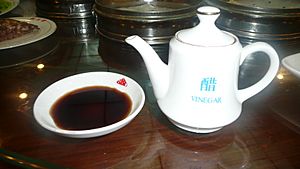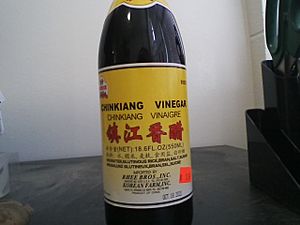Zhenjiang vinegar facts for kids
Quick facts for kids Zhenjiang vinegar |
|||||||
|---|---|---|---|---|---|---|---|
 |
|||||||
| Simplified Chinese | 镇江香醋 | ||||||
| Traditional Chinese | 鎭江香醋 | ||||||
| Literal meaning | Zhenjiang Aromatic Vinegar | ||||||
|
|||||||
Zhenjiang vinegar, also known as Chinkiang vinegar, is a special kind of black vinegar. It's made from rice and is very popular in Chinese cooking. This vinegar gets its name from the city of Zhenjiang in the Jiangsu province of China.
Contents
The Story of Zhenjiang Vinegar
How Zhenjiang Vinegar Began
Long ago, in Chinese legends, people say that a person named Heita invented vinegar. Heita was the son of Dukang. Dukang was a famous hero who helped invent alcoholic drinks in ancient China.
The story says that Heita forgot a big pot of wine for 21 days. When he finally remembered it, the sun was setting. He tasted the wine and found it had turned pleasantly sour! That's how vinegar was supposedly discovered.
A Long History
We know for sure that Zhenjiang vinegar has been made for about 1400 years. That's a very long time! The main company that makes Zhenjiang vinegar today is called Jiangsu Hengshun Vinegar Industry Company. It started making this special vinegar way back in 1840.
How Zhenjiang Vinegar is Made
Making Zhenjiang vinegar is a careful process. It starts with a special mix called "vinegar pei." This mix includes wheat bran, rice hulls, and alcohol made from sticky rice. It also has something called "vinegar seed" from a previous batch.
The First Steps
First, this pei mixture is poured into a large pot until it's about half full. The mixture is kept warm. In summer, it stays warm for up to 3 days. In winter, it needs up to 6 days.
Adding More Ingredients
After this warming time, more rice hulls are added. These are mixed in once every day until the pot is completely full. Then, salt is added to the mixture.
Aging and Finishing
The pot is then stored for up to three months. During this time, the vinegar gets older and develops its rich flavor. This is called the aging process. Finally, the vinegar is taken out. A liquid made from water-soaked, roasted rice is added. This makes the vinegar's color and taste even better!


